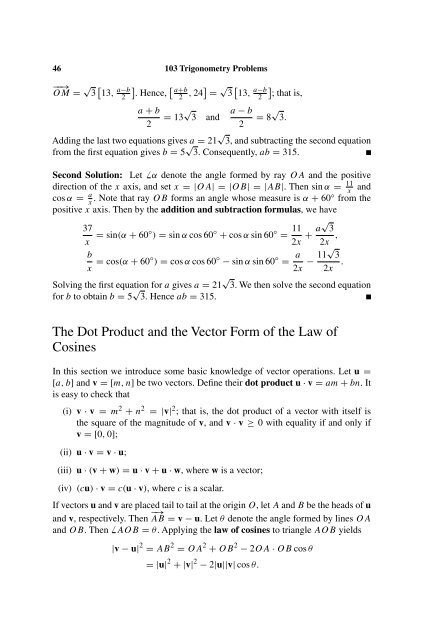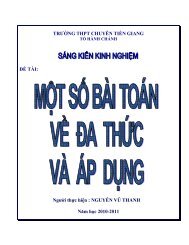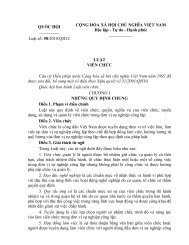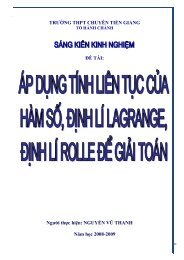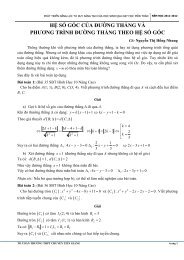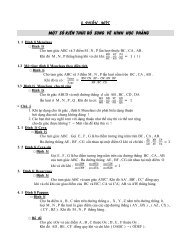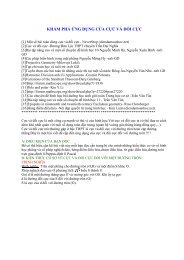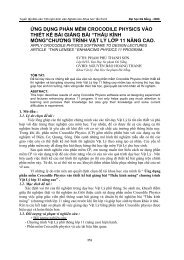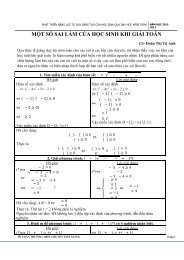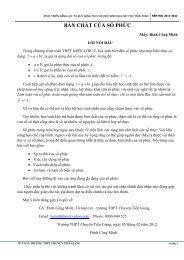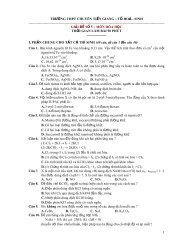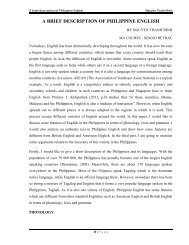103 Trigonometry Problems
103 Trigonometry Problems
103 Trigonometry Problems
You also want an ePaper? Increase the reach of your titles
YUMPU automatically turns print PDFs into web optimized ePapers that Google loves.
46 <strong>103</strong> <strong>Trigonometry</strong> <strong>Problems</strong><br />
−−→<br />
OM = √ 3 [ 13, a−b ] [<br />
2 . Hence, a+b<br />
2 , 24] = √ 3 [ 13, a−b ]<br />
2 ; that is,<br />
a + b<br />
2<br />
= 13 √ 3 and<br />
a − b<br />
2<br />
= 8 √ 3.<br />
Adding the last two equations gives a = 21 √ 3, and subtracting the second equation<br />
from the first equation gives b = 5 √ 3. Consequently, ab = 315.<br />
Second Solution: Let ̸ α denote the angle formed by ray OA and the positive<br />
direction of the x axis, and set x =|OA| =|OB| =|AB|. Then sin α = 11<br />
x<br />
and<br />
cos α =<br />
x a . Note that ray OB forms an angle whose measure is α + 60◦ from the<br />
positive x axis. Then by the addition and subtraction formulas, wehave<br />
37<br />
x = sin(α + 60◦ ) = sin α cos 60 ◦ + cos α sin 60 ◦ = 11<br />
2x + a√ 3<br />
2x ,<br />
b<br />
x = cos(α + 60◦ ) = cos α cos 60 ◦ − sin α sin 60 ◦ = a<br />
2x − 11√ 3<br />
2x .<br />
Solving the first equation for a gives a = 21 √ 3. We then solve the second equation<br />
for b to obtain b = 5 √ 3. Hence ab = 315.<br />
The Dot Product and the Vector Form of the Law of<br />
Cosines<br />
In this section we introduce some basic knowledge of vector operations. Let u =<br />
[a,b] and v =[m, n] be two vectors. Define their dot product u · v = am + bn. It<br />
is easy to check that<br />
(i) v · v = m 2 + n 2 =|v| 2 ; that is, the dot product of a vector with itself is<br />
the square of the magnitude of v, and v · v ≥ 0 with equality if and only if<br />
v =[0, 0];<br />
(ii) u · v = v · u;<br />
(iii) u · (v + w) = u · v + u · w, where w is a vector;<br />
(iv) (cu) · v = c(u · v), where c is a scalar.<br />
If vectors u and v are placed tail to tail at the origin O, let A and B be the heads of u<br />
and v, respectively. Then −→ AB = v − u. Let θ denote the angle formed by lines OA<br />
and OB. Then ̸ AOB = θ. Applying the law of cosines to triangle AOB yields<br />
|v − u| 2 = AB 2 = OA 2 + OB 2 − 2OA · OB cos θ<br />
=|u| 2 +|v| 2 − 2|u||v| cos θ.


